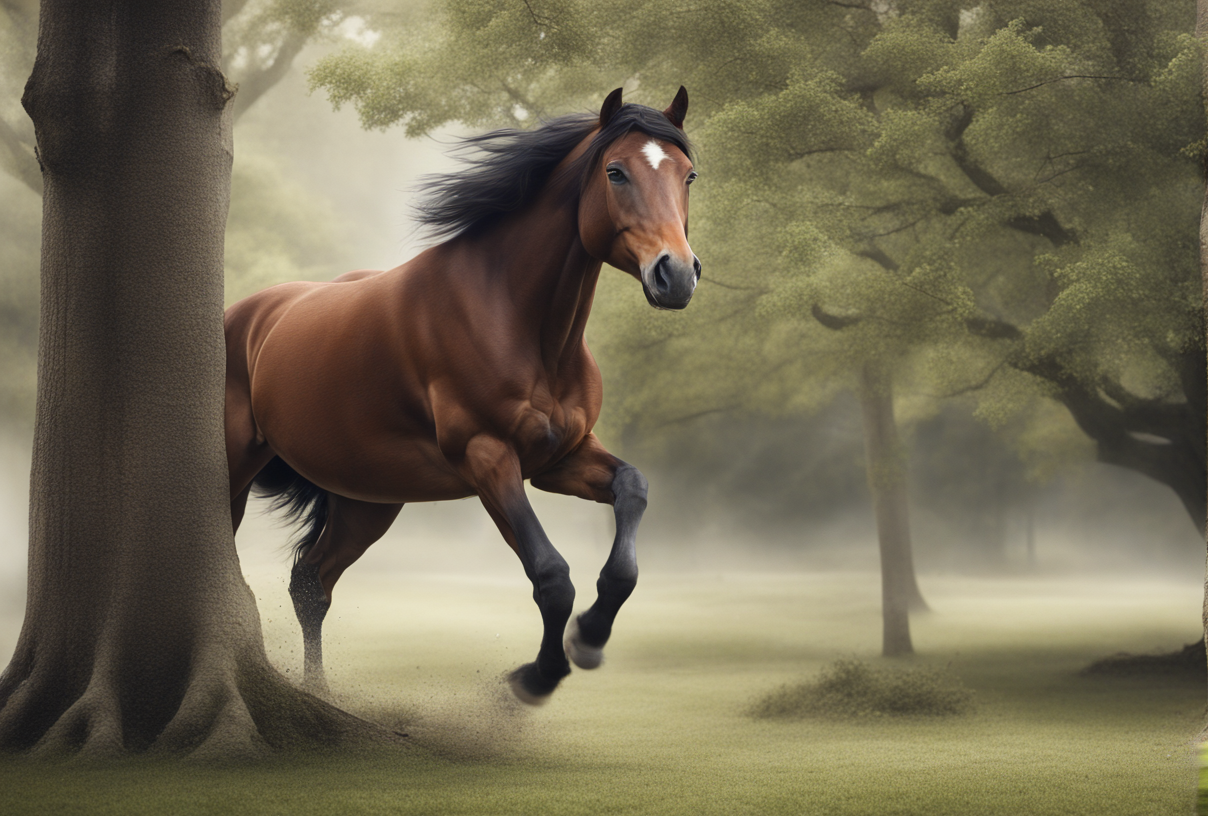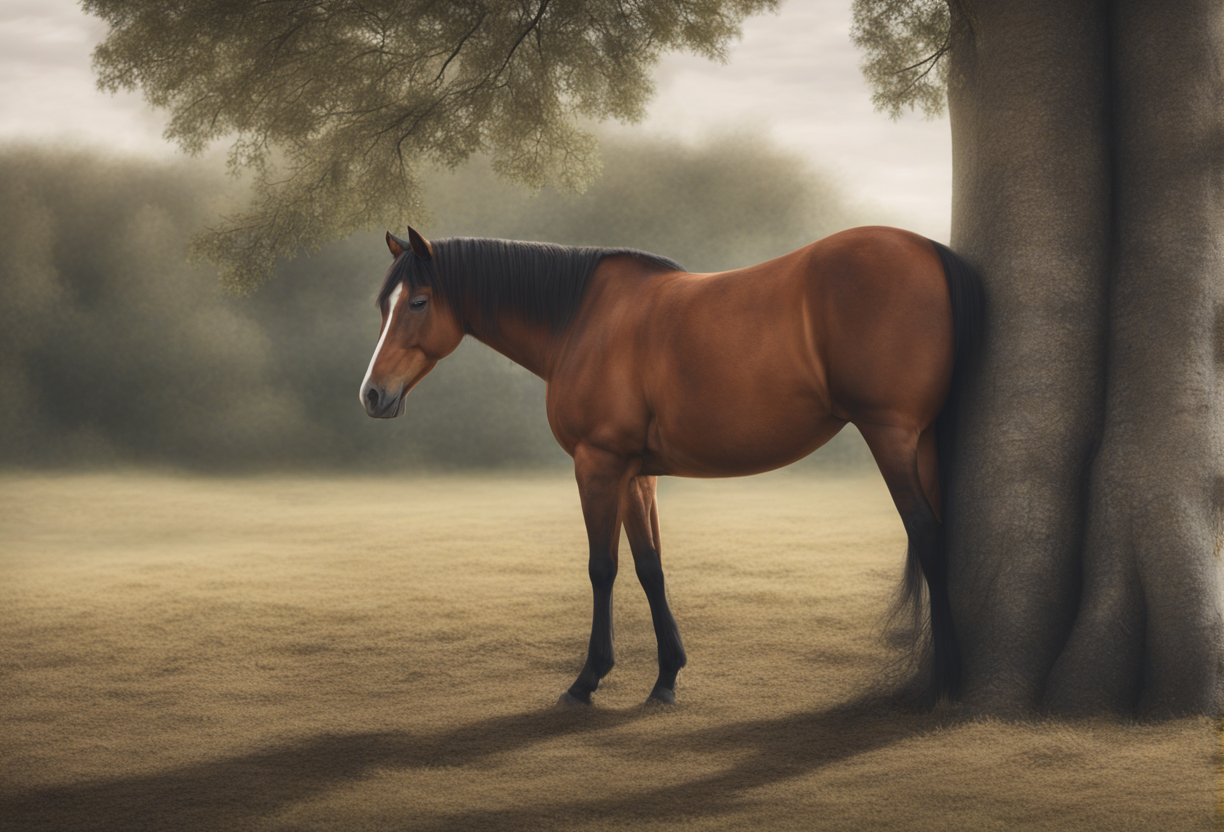Today I want to get to the bottom of a question that has puzzled many equestrians: why do horses kick trees?
As someone who has spent years around horses on my family’s ranch, I’ve seen this strange behavior more times than I can count.
So let me share my experiences and insights with you all!
Now I have to admit, the first time I saw one of our horses rearing up and kicking at a tree trunk, I was totally bewildered.
My immediate thought was, “That poor horse must have lost its mind!” But over time and through careful observation, I’ve come to better understand the reasons behind this quirky equine activity.
First, let me reassure you – horses that kick trees are not crazy or aggressive.
In fact, it’s often a sign that a horse is feeling happy and playful.
Horses kick trees for some of the same reasons kids like to run around and climb on playground equipment – it’s just an outlet for their energy and high spirits.
Table of Contents
Kicking is Natural Horse Behavior
Kicking is a perfectly normal part of a horse’s behavioral repertoire.

In the wild, horses kick to defend themselves from predators, to establish dominance in the herd hierarchy, and sometimes just to express excitement. Domestic horses retain those natural instincts.
I’ve seen horses on the ranch kick out at each other when competing for food or asserting their place in the pecking order.
The lead mare might give a good kick to a lower-ranking horse that doesn’t respect her space. Or in the frenzy of feeding time, one horse might get a swift boot to the shoulder for crowding another.
Stallions and geldings may kick when battling for the affections of a mare in heat. I’ve also seen horses deliver fierce kicks to scare off predators like coyotes or dogs that get too close. So kicking is very much an ingrained survival skill and social behavior for horses.
This instinct doesn’t switch off just because the horse is domesticated. If anything, horses cooped up in stalls or small paddocks have even more pent up kicking energy! With no herd hierarchy to negotiate or predators to fend off, they look for alternate targets. That’s where sturdy tree trunks come in handy.
I’ll never forget the first time my young colt Rusty reared up and gave the old oak tree by his paddock a proper thrashing with his hind legs.
The loud whacks echoed across the ranch! I rushed over, afraid he’d hurt himself. But Rusty just stared at me as if to say “Well, I had to kick something!” He gave a snort and went right back to contentedly munching hay like nothing happened.
In that moment, I realized tree kicking is just horses being horses. For Rusty, the oak tree made a perfect pell just like the kick bags we hang in the barn for the horses to practice their moves.
Except this “kicking bag” weighed a ton and wouldn’t move no matter how hard he struck it. That solid connection is satisfying to horses on a primal level.
Stretching Their Legs
Horses are athletes – they love to stretch and move their powerful muscles.

But if they’re confined to a small space like a stall or paddock, they don’t get enough opportunity to work out those muscles as nature intended.
Kicking trees allows horses to fully extend their hind legs and get that satisfying feeling of exertion.
It also helps them strengthen their legs and practice balance and coordination. So don’t worry when you see a horse kicking a tree – think of them as doing resistance training with nature’s punching bag!
Horses’ powerful hind limb muscles are designed for running, bucking, and delivering vigorous kicks. In the wild, horses are in near constant motion as they graze over large territories. Domestic horses are often confined to stalls or small paddocks with limited room to move.
This unnatural physical restriction can cause muscular stiffness and joint stress over time. Kicking a tree gives a horse the chance to fully extend those compacted hind legs and get that sweet release of using their muscles to their full capacity.
I like to give my horses plenty of time roaming free in the pasture to stretch their legs. But even then, they’ll often seek out a tree for extra leg stretches. My mare Belle is religious about finding a oak sapling to kick each morning right after I turn her out. She’ll give it a few vigorous boots while shaking out her mane. I swear I can see her smiling with relief afterwards!
Working the balancing muscles is another benefit. Bracing the body to deliver powerful kicks improves core strength and coordination. This “kick training” comes in handy for trail rides when horses need to maintain balance over uneven terrain. So generally, I see it as beneficial “exercise equipment” for them!
Alleviating Boredom
Horses are highly intelligent, active animals. If they don’t have enough mental stimulation and physical activity, they get bored. A bored horse may kick trees to relieve frustration or just for something entertaining to do.

Make sure your horse has opportunities for learning new skills through training, plenty of room to roam in turnout, and enrichment activities like treat-filled puzzle toys. A horse that’s happily engaged with its environment is less likely to need to kick trees out of boredom.
Horses have evolved to travel many miles a day grazing, foraging, and exploring their environment. But stabled horses may spend 23 hours a day confined to a 12×12 stall with little to do. It’s no wonder they develop vices like cribbing or repetitive behaviors like tree kicking to deal with boredom.
I noticed this with a new boarding horse named Chance that came to our ranch last year. Chance was in a small paddock all day with no other horses for companionship while his owner was at work. He started spending hours just staring at the fence and listlessly kicking the old pecan tree. It was clear he was bored out of his mind.
As soon as we moved Chance to a bigger pasture with a small herd, his tree kicking stopped. He was too busy grazing, playing, and socializing to bother with the tree. Providing more mental stimulation through training also helped. Once Chance could focus on learning new ground work skills during the day, he no longer seemed bored.
Simple things like placing a tasty flake of hay in a small-holed net for horses to nibble out or hanging a Jolly Ball to bat around can also deter boredom. Just be sure to rotate toys so they remain interesting.
Communication & Marking Territory
In the wild, horses use kicking against trees and other objects to communicate with each other. The loud, reverberating sound serves to signify a horse’s presence and warn others away from their space.
Domestic horses retain some of that marking behavior – by kicking a tree in their paddock, they’re announcing “This space is mine!” It helps them feel secure.
They also might be leaving visual marks on the bark to say “Kilroy was here!” Or communicating to a neighboring horse they can’t see over a fence. So don’t discourage this natural communication too much.
Horses are highly social herd animals – they need to know where they fit in the pecking order and have their status respected. Kicking trees is one way domestic horses try to maintain that social structure, even with limited horse contact.
By kicking fence posts and trees at the boundaries of their paddock, horses seem to be leaving visual cues about who “owns” that space. I’ve noticed my alpha mare Lucy likes to deliver adaily kick to the big pine tree in the corner of her paddock. She’ll then stand tall facing the tree with an expression that seems to say “Yeah, I’m the boss here!”
Tree kicking also serves to signal a horse’s presence to others. My gelding Beau will often kick the oak tree right by the fence dividing his paddock from Rocky’s paddock. This carries the sound over to Rocky, reminding him Beau’s still around. Since horses have a dominance hierarchy, Beau wants to make sure Rocky doesn’t forget he’s top horse.
And when horses can see or hear each other but can’t directly interact, tree kicking seems to serve a communication function. I’ve seen horses parked side-by-side in the barn aisle way take turns kicking their stall doors when feeding time nears, as if urging each other to get ready for dinner.
When Tree Kicking Becomes a Problem
While the occasional tree kick is no cause for concern, excessive or forceful kicking can damage trees and even injure a horse. If you notice frequent, aggressive tree-pummeling behavior, or see damage to your horse’s hooves, it’s time to intervene.
Make sure a veterinarian checks for pain issues that could be causing the behavior. Then work on addressing the likely source – boredom, confinement, lack of exercise, etc. With the right changes, the tree-kicking should subside.
Kicking is a natural behavior for horses, but excessive kicking can lead to issues. I knew we had a problem when my gelding Buck started kicking the fence posts multiple times a day with his full strength. The fence boards were looking battered and Buck’s hooves were chipped and cracked.
A vet exam showed Buck had no pain causing this overkill kicking. So I had to get to the root of his motivation. I realized Buck was kicking from boredom and frustration over being alone in his paddock since his pasture buddy left.
To help Buck, I increased his turnout time and put a new companion goat named Billy in the adjacent paddock for company. Making his stall more enriching with toys and changing his feeding schedule to small, frequent meals also helped occupy Buck.
Within a week of these changes, Buck’s obsessive kicking had stopped completely. His hooves could heal and the fence no longer shook with the force of his blows. Getting to the source of excess kicking and making adjustments to care is key.
Well friends, I hope this expanded breakdown has helped explain the mystery of horses kicking trees. Let me know if you have any other equine behavior questions on my FB!